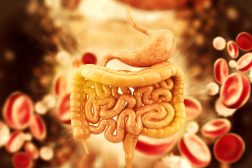
Fibrinous exudate
n., plural: fibrinous exudates
[fɪbrɪnəs ˈɛɡzjʊdeɪt]
Definition: A thick, yellowish fluid composed of fibrin and inflammatory cells that forms during the inflammatory response
Table of Contents
What Is Fibrinous Exudate?
Fibrinous exudate is a type of exudate (inflammatory fluid) that forms at the site of tissue injury or inflammation as part of the body’s immune response. It is characterized by being sticky and thick in consistency and is primarily composed of fibrin (hence, the name).
In humans and other animals, exudate is a fluid that escapes from the blood vessels. It accumulates in the tissues or body cavities, such as when the tissue is inflamed, infected, or damaged. Typically, an exudate consists of water, proteins, electrolytes, and inflammatory cells. Nevertheless, this composition may vary depending on the underlying cause and the specific tissues or organs involved. For instance, the fibrinous exudate consists primarily of fibrin, a fibrous protein known for its role in blood clotting.

Is it normal for the human body to exude fibrinous exudate?
Fibrinous exudates are normally produced when the tissues are damaged. They serve as a temporary scaffold or matrix at the site of injury. They help contain the damage by preventing the spread of infection and supporting tissue repair. In particular, they provide a framework for the migration of reparative cells and the formation of new blood vessels (angiogenesis). However, when inflammation is prolonged, the condition could lead to complications, e.g., tissue adhesions.
How come the fluid escapes from the blood vessels anyway?
During the inflammatory phase, basophils and the mast cells residing at the site of injury release histamine, which contributes to the inflammatory response. It dilates the blood vessels at the site of injury. This causes increased vascular permeability to immune cells and other inflammatory mediators. Furthermore, bradykinin, another inflammatory mediator, is formed where the injury occurs through the activation of the kinin-kallikrein system. Similar to histamine, bradykinin promotes blood vessel dilation and vascular permeability.
Histamine and bradykinin (as well as other inflammatory mediators) act on the blood vessel, causing it to dilate. Consequently, while recruiting immune cells from the bloodstream to the injured site, the fluid in the blood vessel escapes.
Blood proteins, such as fibrinogen, also accumulate at the site. Fibrinogen is a soluble protein in blood plasma that is converted to fibrin through the action of thrombin during blood clot formation.
The escaped fluid, along with blood proteins and the inflammatory cells and mediators, that has accumulated in the affected tissue is the reason for the visible or palpable enlargement of the affected area (edema).

Watch this vid about extravasation (i.e., the movement of cells out of the blood vessel into tissue during inflammation):
Biology definition:
A fibrinous exudate is a specialized type of inflammatory fluid that the body releases in response to tissue injury or inflammation. It is characterized by being made chiefly of fibrin, thus, the name. It has a thick and sticky consistency. This type of exudate is seen in rheumatic carditis, strep throat, and bacterial pneumonia.
Etymology: fibrinous, from fibrin (from Latin fibra meaning fiber + –in) + –ous + exudate, from exude meaning to ooze, which came from the Latin exsūdāre (to sweat out, i.e. ex– meaning “out” and sūdāre meaning “to sweat“)
Characteristics of Tissue With Fibrinous Exudate
Exudates have different types, such as serous, purulent, hemorrhagic, and catarrhal exudates, that are distinguished by their composition, underlying cause, and the specific stage of inflammation. For a table summary of the different types of exudates along with properties, read this.
Fibrinous exudate is characterized by the following distinct features:
- The presence of fibrin meshwork, which appears as a sticky, dense, yellowish-white, or pale gelatinous material from the accumulation of fibrin
- Appears firmer or more rigid due to the fibrinous exudates that add density to the inflamed area
- Forms a more organized structure than the other exudates
- May eventually form adhesions between tissues or organs (abnormal tissue connections)
- Implicates normal healing but often indicates a more severe or intense inflammatory response. Compared to other exudates, such as serous exudates which are often associated with mild inflammation, fibrinous exudates are often associated with more severe infections or severe tissue injury. Thus, they also tend to take a longer period to resolve than the other types of exudates.
- When examined under a microscope, tissues with fibrinous exudate may show fibrin deposits and the presence of inflammatory cells, particularly neutrophils.
In fibrinous exudate, the key is “fibrin”…
Fibrin is a protein that results when the fibrinogen is transformed by thrombin during blood clot formation. Thrombin cleaves fibrinopeptides (small peptide chains) from fibrinogen, converting it into fibrin. Fibrin molecules interact with each other forming a fibrin polymer. Factor XIIIa forms covalent bonds between neighboring fibrin molecules (crosslinking), creating a fibrin mesh-like structure.

The resulting fibrin meshwork functions as a temporary scaffold that traps platelets, red blood cells, and other components to stop bleeding and facilitate tissue repair at the site of injury.

Is Fibrinous Exudate An Infection?
Fibrinous exudate itself is not an infection, but rather a type of fluid that forms as a part of the body’s immune response to an infection or tissue injury. As discussed above, fibrin is a protein involved in blood clots. Thus, an exudate that is fibrinous does not necessarily indicate infection (presence of infectious material). Nevertheless, the presence of pus, in turn, often indicates infection as it contains dead white blood cells and bacteria. (As in the case of suppurative inflammation wherein the suppurative exudate consists of pus elements). A fibrinous exudate combined with pus (referred to as fibrinopurulent exudate) can indicate infection as it is a type of exudate where both fibrin and pus coexist at the site of inflammation.
What is the Fate of Fibrinous Exudate?
Over time, the fibrinous exudate will be broken down and removed by the body’s immune system. This will therefore resolve the inflammation. However, uncontrolled, excessive, prolonged, or unresolved fibrinous inflammation could lead to complications, such as the formation of scar tissue or adhesions.
How long fibrinous exudate stays depends on the underlying cause and the individual’s immune response. In most cases, it resolves within a few days to a couple of weeks as the inflammatory process subsides and the body’s immune system breaks down and removes the fibrinous exudate.
NOTE IT!
FAQ on Fibrinous Exudates
What causes the formation of fibrinous exudate?
Fibrinous exudate results in response to various factors, including tissue injury, infection, or inflammation. When tissues are damaged or infected, the immune system releases fibrin, which forms a network of thread-like structures. They undergo crosslinking, creating a meshlike structure that characterizes a fibrinous exudate.
Is fibrinous exudate harmful? Can it affect other tissues?
Fibrinous exudate is a normal part of the body’s inflammatory response. However, if prolonged or excessive, it may lead to the formation of scar tissue or adhesions, which can cause complications that may interfere with the normal function of affected organs or tissues. Also, it may affect nearby tissues. As the inflammatory process progresses, the fibrinous exudate may interact with blood serum and the surrounding tissue. Nearby tissues may experience changes in their microenvironment due to the accumulation of fibrinous exudate. The protein content of the exudate can lead to increased osmotic pressure in the affected area, resulting in fluid accumulation and swelling (edema) in the nearby tissues.
What are the different types of fibrinous inflammation?
The types of fibrinous inflammation can be classified based on their location or underlying cause. Here are some common types:
- Fibrinous Pleuritis: fibrinous inflammation of the lungs, particularly the pleural membranes that line the chest cavity and surround the lungs
- Fibrinous Pericarditis: fibrinous inflammation of the pericardium, the sac-like membrane that surrounds the heart
- Fibrinous Peritonitis: fibrinous inflammation of the peritoneum, the membrane lining the abdominal cavity
- Fibrinous Arthritis: fibrinous inflammation affecting the joints
- Fibrinous Meningitis: fibrinous inflammation of the meninges, the protective membranes surrounding the brain and spinal cord
- Fibrinous Tissue Wound Healing (Fibrinous exudate wound): In some cases, fibrinous inflammation can occur as part of the wound healing process, especially in large or severe wounds.


Take the Fibrinous Exudate – Biology Quiz!
References
- Robbins and Cotran Pathologic Basis of Disease: This widely-used pathology textbook covers various aspects of fibrinous exudate in the context of inflammation and tissue injury.
- Kumar, V., Abbas, A. K., Aster, J. C., & Robbins, S. L. (Eds.). (2021). Robbins Basic Pathology. Elsevier: This pathology resource provides valuable insights into the mechanisms and clinical significance of fibrinous exudate.
- Medscape: Medscape is an online medical reference platform that offers articles and clinical insights on various medical topics, including fibrinous exudate. It is written and reviewed by medical professionals and experts.
©BiologyOnline.com. Content provided and moderated by Biology Online Editors.








